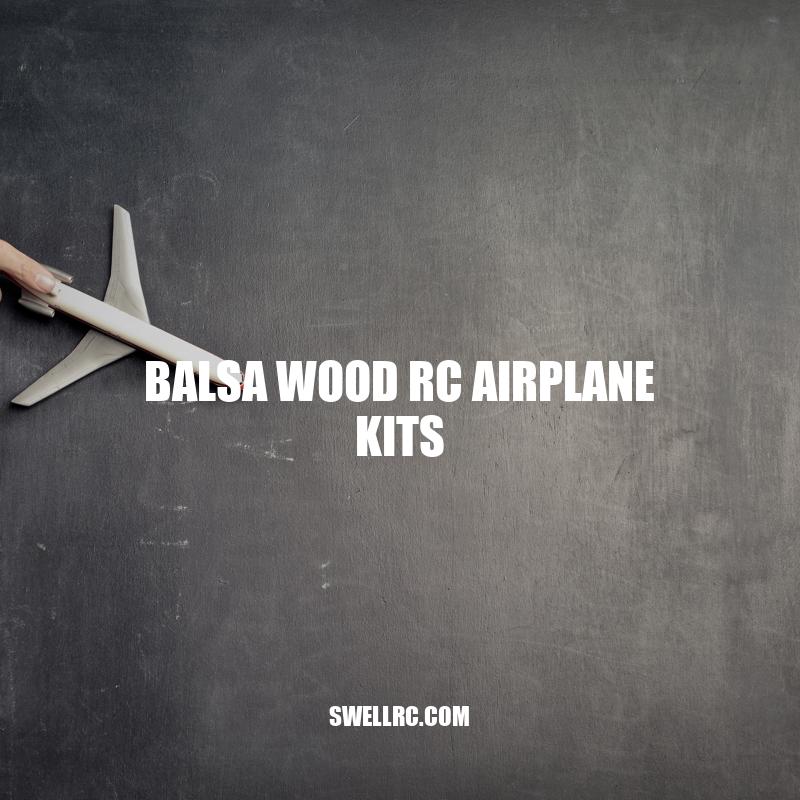Building with Balsa: The Ultimate Guide to RC Airplane Kits
Building and flying RC airplanes is a popular hobby that has been enjoyed for many decades. While there are ready-to-fly models available, many hobbyists prefer to create their own planes from scratch. Balsa wood is a popular choice for building RC airplanes as it is lightweight, strong, and easy to work with. Balsa wood RC airplane kits provide a fun and rewarding way for hobbyists to build their own planes while also learning about aerodynamics and craftsmanship. These kits come in various levels of difficulty, from beginner to advanced, and provide an ideal entry point for anyone interested in the hobby. Regardless of skill level, building an RC airplane from a balsa wood kit requires patience, precision, and attention to detail. The end result is a unique, personalized airplane that the builder can fly and proudly display. In this article, we will explore the benefits of balsa wood RC airplane kits, how to choose the best one, tips for building, safety precautions, and why this hobby is so rewarding.
Advantages of Balsa Wood in RC Airplane Kits
Balsa wood has been used in construction of model airplanes and RC planes since the early 1900s due to its excellent strength-to-weight ratio, making it an essential material for building high-performance planes. Below are some advantages of using balsa wood in RC airplane kits:
- Lightweight: Its weight is ideal for creating planes that require both speed and maneuverability.
- Durable: Its inherent strength makes it resistant to bending or breaking under stress.
- Flexibility: Balsa’s natural flexibility provides shock absorption for landings or crashes.
- Affordability: Balsa wood is inexpensive compared to other materials used to build airplanes such as carbon fiber.
- Easy to work with: Balsa wood is soft, easy to cut, shape and sand thereby reducing the need for advanced tools. It can also be painted or stained without any complications.
- Versatility: Balsa wood can be used for all parts of an airplane, including the wings, fuselage, and tail.
For a wide range of balsa wood RC airplane kits, hobbyists can check out websites such as HobbyLinc, which offers various types of balsa wood kits to suit different levels of experience. Another popular website for purchasing balsa wood kits is Tower Hobbies, which has a range of plane kits in different sizes, from small park flyers to large scale warbirds.
What is the best wood for RC planes?
When it comes to building RC planes, choosing the right material for construction is crucial, and using the right type of wood is no exception. There are many types of wood to choose from, and each has its own unique qualities that make it ideal for certain types of RC planes. However, some woods are more suited to RC plane building than others.
One of the most popular woods for building RC planes is balsa. Balsa is a lightweight wood that is easy to work with and has excellent strength-to-weight ratio. This makes it a popular choice for building lightweight, high-performance planes that can fly at high speeds and do tricks in the air. Balsa can also be layered and shaped to create custom designs that suit the builder’s needs.
Another popular wood for building RC planes is plywood. Plywood is a versatile material that is strong, lightweight, and relatively inexpensive. It is often used to build the wings and fuselage of RC planes, and it provides excellent stiffness and durability. Plywood is also moisture-resistant, which makes it ideal for use in outdoor planes.
Other types of wood that are commonly used in RC plane construction include spruce, basswood, and cedar. Spruce is an excellent choice for building spars, while basswood is ideal for building wings and fuselages. Cedar, on the other hand, is a lightweight and durable wood that can be used for both indoor and outdoor planes.
In conclusion, choosing the best wood for RC planes depends on the builder’s needs, the type of plane being built, and the desired performance. Balsa, plywood, spruce, basswood, and cedar are all excellent options for building RC planes, and each has its own unique strengths and weaknesses. Ultimately, the best wood for RC planes is one that is easy to work with, strong, lightweight, and suited to the builder’s needs and preferences.
Selecting the Best Balsa Wood RC Airplane Kit
Choosing the best balsa wood RC airplane kit can be a daunting task, especially for beginners. Here are some factors to consider to ensure you get the right kit for your experience level and needs:
- Skill level: Determine if the kit is suitable for beginners, intermediates, or advanced model builders.
- Budget: Some balsa wood airplane kits can be quite expensive. Determine how much you are willing to spend before making your purchase.
- Size of plane: Determine the size and type of airplane you want to build to ensure you get the right balsa wood kit.
- Reviews: Check reviews from other modelers to find out their experiences with the kit before making a purchase.
- Manufacturer: Choose a reputable and experienced manufacturer to ensure you have access to good customer support and reliable resources.
There are a number of websites and stores that offer high-quality balsa wood RC airplane kits in varying sizes and levels of difficulty. For example, you can find a range of beginner to advanced level balsa wood RC airplane kits available on Amazon. If you’re looking for specific aircraft models to build, you can browse kit manufacturers’ websites such as SIG Manufacturing, which offers a variety of balsa airplane kits for experienced and beginner builders alike.
Tips for Building Balsa Wood RC Airplane Kits
Building balsa wood RC airplane kits requires precision, patience, and attention to detail. Here are some tips to help you build your airplane successfully:
- Read the instructions carefully and familiarize yourself with the kit before starting.
- Use a sharp hobby knife to cut the balsa wood accurately. Sand the edges with sandpaper to give a smooth finish.
- Pay attention to the grain of the balsa wood when cutting to prevent it from splitting or breaking.
- Use a high-quality adhesive to glue the wood together. Apply glue sparingly to prevent excess glue from ruining the finish of your airplane.
- Allow the glue to dry completely before moving to the next step to ensure a secure bond.
- Test fit all parts of the kit before gluing to ensure they fit together properly. Adjust as needed.
- Take your time and don’t rush the building process. Building balsa wood airplanes is a time-consuming hobby, and the results are worth the effort.
In addition to these tips, there are a number of helpful resources online to help you build your balsa wood RC airplane kit successfully. YouTube has a wealth of instructional videos, with step-by-step guidance on how to build an assortment of models. You can also find a range of forums and online communities that share tips on building balsa wood airplanes, as well as offer advice on specific kit models.
Which materials are best suited for building RC aircraft?
Building an RC aircraft requires careful selection of materials that can withstand the stress and conditions of flight while maintaining lightweight and aerodynamic properties. Some commonly used materials in building RC aircraft include balsa wood, foam boards, carbon fiber, Kevlar, and aluminum.
Balsa wood is a popular choice for model airplanes due to its lightweight and easy-to-work-with properties. Its strength-to-weight ratio makes it an ideal choice for making airplane frames and wings.
Foam boards, especially expanded polystyrene foam and Depron foam, are also popular for RC aircraft construction. They are lightweight, cheap, and easy to shape. They can be used for making the entire airframe or making coverings for balsa wood frames.
Carbon fiber and Kevlar are high-strength, light-weight materials used in the construction of high-performance RC aircraft, especially those designed for aerobatics and extreme maneuvers. These materials are used in making custom parts such as reinforcement structures, landing gears, and control surfaces.
Aluminum is another material used in RC aircraft construction, particularly for larger models. It is strong and rigid, making it suitable for constructing landing gears, engine mounts, and other structural components.
In conclusion, selecting the right material for your RC aircraft depends on the design and size of the aircraft, its intended use, and your budget. Each material has its unique strengths and weaknesses, and it is essential to use the appropriate material combination to achieve the desired result.
Safety Precautions When Working with Balsa Wood RC Airplane Kits
While building balsa wood RC airplane kits can be a rewarding and enjoyable hobby, it is important to take proper safety precautions to avoid health hazards. Some safety measures to take include:
- Wear a dust mask and safety goggles to protect yourself from inhaling wood dust, which can cause respiratory and eye irritation.
- Work in a well-ventilated area to ensure good air circulation and reduce exposure to wood dust.
- Avoid touching your eyes, nose, or mouth while handling balsa wood to prevent irritating irritation or infection.
- Use a sharp hobby knife and handle it carefully to avoid cuts and other injuries.
- Store your tools and materials in a safe and secure place when not in use to prevent injury to yourself or others.
- Dispose of sawdust and other debris in a safe and responsible manner to avoid creating a fire hazard or damaging the environment.
By taking these safety precautions, you can reduce the risk of injury and create a safer working environment for yourself and those around you. In addition to these tips, it is always a good idea to read the instructions and follow the manufacturer’s safety guidelines when building your balsa wood RC airplane kit.
If you’re looking for high-quality balsa wood RC airplane kits brands, Great Planes and Horizon Hobby are great options. These brands offer a range of balsa wood RC airplane kits suitable for both beginners and experienced modelers alike. Make sure to follow the safety precautions and enjoy building your RC airplane kit!
What is safe in RC planes?
RC planes can be an exciting hobby, but safety must be a top priority. Thankfully, there are several things you can do to ensure that you and others are safe when flying RC planes.
Firstly, make sure that you are operating your RC plane in a safe and appropriate location. This means not flying your plane in crowded areas or near airports, which could pose a risk to other people or aircraft.
Secondly, always maintain a safe distance from your RC plane when it is in flight, as the propeller can be extremely dangerous if it comes into contact with a person or object.
In addition, you should carefully inspect your RC plane before each flight to ensure that it is in proper working order and that all of its components are securely attached. This can help prevent accidents due to mechanical failure.
Finally, it is important to always use common sense and good judgment when flying RC planes. If you are unsure about something or if conditions are less than ideal, it is better to err on the side of caution and not fly your plane.
By taking these precautions, you can help ensure that you and others remain safe while enjoying the excitement of flying RC planes.
Conclusion
In conclusion, balsa wood RC airplane kits are an excellent choice for hobbyists who enjoy building and flying model airplanes. Balsa wood offers a unique combination of strength, flexibility, and lightweight that makes it ideal for constructing RC planes. There are many different kits available to suit beginners, intermediate builders, and advanced hobbyists, so it is easy to find one that matches your skill level and budget. By following the instructions carefully and taking proper safety precautions, you can create a successful and rewarding build that you can be proud of. With its beautiful finish and excellent aerodynamic properties, balsa wood RC airplanes are sure to turn heads both on the ground and in the sky. So why not give it a try today and enjoy the satisfaction of building your own balsa wood RC airplane?



